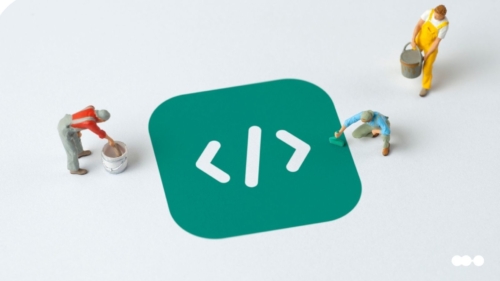
RPA vs. BPM: What is the difference?
RPA and BPM are two of the most common terms in the world of process management. But what is the difference between RPA vs. BPM? Is their relationship competitive or complementary? How do businesses use RPA and BPM?
This short post will answer these questions and help you understand the role each of these two technologies plays in your business.
The Definitive Guide to Business Process Automation
Learn more about BPA including common use cases and benefits.

What is Robotic Process Automation (RPA)?
Robotic process automation (RPA) is software that completes a specific task. This code (or script) is referred to as a “bot.” Each bot can complete one type of task. For example, your business may use a bot that retrieves data from one system and enters it into another. This work was formerly done by an employee who now has more free time to focus on other priorities.
While each bot completes one specific type of task, groups of bots may be coordinated so that each bot solves one task in a workflow or process.
RPA requires code in order for the bots to work. If the task changes, the bot will need to be re-coded. In order to code the bot correctly, the steps in the task will need to be documented in detail by the person who is familiar with the task, or by an SME.
What is RPA used for?
RPA is ideal for automating specific, structured tasks that follow the same steps every time. For example, RPA bots can be programmed to:
- Retrieve and enter data.
- Scrape data from websites.
- Process online orders.
- Create shipping labels.
- Read forms and transfer data into a system.
- Route requests or workflow items.
- Convert speech into data.
Limitations of RPA
- RPA bots require coding experience and must be re-coded if the task they automate changes.
- RPA does not optimize tasks or workflows. It simply automates them in their current state.
- RPA is not ideal for highly complex tasks that require decision-making or problem-solving.
- RPA does not include an embedded orchestration layer, so multiple bots must be coordinated using an additional system or tool.
What is Business Process Management (BPM)?
Business process management (BPM) can be a confusing term. That’s because it’s been around for a long time and it’s often used to refer to both the discipline of BPM and the tools used within that strategy. To simplify things, here’s a quick overview.
BPM is the discipline of planning, optimizing, and monitoring all the processes that happen within an organization. BPM includes both strategic and tactical components. On the strategic side, BPM is about making sure that processes allow the business to achieve its overall goals. As a tactic, BPM refers to the hands-on work of mapping, modeling, and building processes, as well as monitoring their performance and optimizing them when needed.
So that’s what BPM really is; a multi-faceted discipline that may also refer to software that helps businesses do all of these things. In other words, BPM, BPM tools, and BPM solutions are terms that refer to the software products businesses use to organize and actualize their BPM strategy.
Example
Process mapping is a common BPM practice that helps people understand the components and sequence of a particular process, as well as whether or not it can be improved. A BPM specialist might be able to do this with a pen and paper or on a whiteboard, or they might use BPM software that creates a digital visualization of the process on their laptop. In either case, the end result is the same. Whether it’s a tool or a discipline, the point of BPM is to understand, control, and improve processes.
What is BPM used for?
As a tool or solution, BPM software supports process management in a few different ways. While there will always be some variance in the complexity and features of different BPM tools, BPM software can be generally used to:
- Coordinate the people and technology that enable processes.
- Map existing processes or model new ones.
- Manage data and documents that move through the process.
- Enable and improve collaboration.
- Organize and execute overall process strategy.
RPA vs. BPM summary
| Aspect | RPA | BPM |
|---|---|---|
| Description | Blocks of code that complete simple and structured tasks. | Complex software with many features that support mapping, monitoring, and modifying processes. |
| Use case | Repetitive tasks that do not require decision-making skills. | Building and optimizing workflows and processes. |
| Skills | Bots require coding skills to create, modify, and maintain. | Some BPM features do not require coding experience and may be accessible with a drag-and-drop interface. |
| Scope | Highly specific; each bot completes one type of task. | BPM software may be used to manage different types of processes in many departments. |
| Limitations | Requires coding experience and must be updated each time the task structure changes. RPA is not well-suited for complex tasks or unstructured data. | May be too complex for simple automation use cases. Features vary depending on the product. Implementation may be complicated and take time to complete. |
| Impact | Automates repetitive tasks to reduce manual work, increase speed, and avoid errors. | A strategic solution that helps the business meet its overall goals. Process optimization capabilities improve efficiency and customer experience. |
| Verdict | Best for solving discrete automation needs. | Best for managing a broad range of processes and workflows across many departments. |
When to use RPA vs. BPM
The determining factor in choosing an RPA or BPM solution is really the scope of your goal. If automating simple tasks is all that is required, then RPA may be the best choice. Keep in mind that RPA will require coding experience to implement and maintain.
When the needs go beyond creating more efficient processes through automation, then BPM may be the best choice. BPM software can manage automation, but it also brings a much broader range of process management capabilities to the table.
BPM and RPA combined
Many organizations rely on both BPM and RPA to optimize and automate processes and achieve digital transformation. For some organizations, the fusion of BPM and RPA takes place in the broader context of a hyperautomation initiative. Hyperautomation typically combines several technologies including RPA, artificial intelligence, and machine learning.
For other organizations, the benefits and capabilities of BPM and RPA can be acquired through the use of a business process automation (BPA) tool.
What is BPA?
Business process automation (BPA) is a category of software that organizations use to automate tasks, workflows, and processes. In addition, BPA software includes other process management features such as
- Low-code framework and visual interface
- Process mapping
- Process visualization
- Process orchestration
- Reporting and real-time data analytics
- Document generation and routing
- Integration with existing apps and systems
BPA solutions can be used to build, manage, scale, and coordinate many types of business processes in virtually any department or industry. BPA is also a low-code solution, which means that business users can create, modify, and automate some processes once they have been given permission from the IT team. This low-code functionality helps balance the business team’s need for agility with the IT team’s need for security and control.







